BIRDS AS ART BULLETIN #242
SEPTEMBER 17, 2007
Visit www.birdsasart.com
CHUCK WESTFALL’S AF COMMENTS
CONGRATS TO DAVID FYLES
JIM NEIGER’S FLIGHT SCHOOL WORKSHOPS
BOSQUE APTATS WORKSHOPS
MIII USER’S GUIDE KUDOS & INFO
MORE EOS 1D MARK III COMMENTS…
IPT UPDATES
Contact us by phone at 863-692-0906 (Eastern Time Zone) or by e-mail at birdsasart@att.net or birdsasart@verizon.net. The att e-mail address is best from overseas.
We gladly accept credit card orders by phone 8am till 9pm Eastern Time (8 am till 3pm Fridays).
You can use the PayPal links on the web site to order anything. Just type in the item(s) and the amount. If using your own PayPal account, please send to either of the e-mail addresses above.
Note: maximize this e-mail for best formatting.
Photographic theme: Images from my recent NY visit.
Important Request: Please note that Artie is without email through the end of September--please hold any questions for him until his return.
If responding to this e-mail, please take the time to delete all images and all irrelevant text.
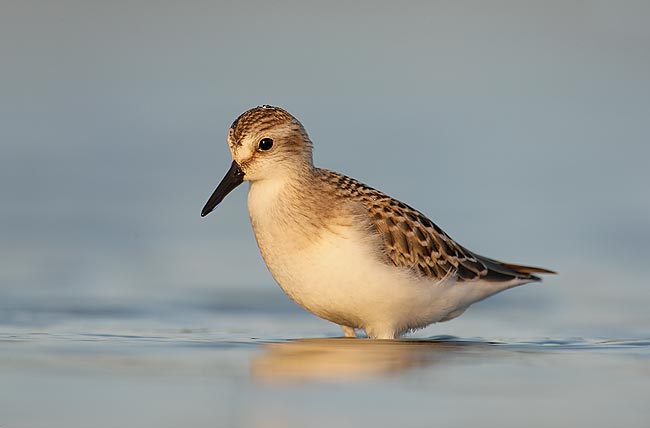
Semipalmated Sandpiper, juvenal plumage, East Pond, Jamaica Bay Wildlife Refuge, Queens, NY
Image Copyright 2007: Arthur Morris/BIRDS AS ART
Canon 500mm f/4L IS lens with the 2X II TC and the EOS-1D Mark III. ISO 800. Evaluative metering +2/3 stop: 1/800 sec. at f/9.
I visited the north end of the East Pond on two afternoons and did well each time. It was—as expected—wetter and muddier there than at the south end of the pond…
CHUCK WESTFALL’S AF COMMENTS
Chuck Westfall is one of Canon’s top tech reps. Below are a selection of his comments that might prove helpful to many of you.
There are several ways to select focusing points on the 1D Mark III:
Manual selection of a single focusing point.
Manual selection of single focusing point, with C.Fn III-8-1 (selected point plus 1 point on either side when possible, for a total of up to 3 active points).
Manual selection of single focusing point with C.Fn III-8-2 engaged (selected point plus 1 point in all available directions, for up to 7 active points).
When the focusing point is manually selected, the 1D Mark III can be set up to allow selection of 9 inner points plus center point, 9 outer points plus center point, or 18 points plus center point.
Automatic focusing point selection mode (camera selects focusing point automatically.)
The
information below is accurate for all Canon 1D class cameras (including
the EOS 1D MII).
Automatic Focusing Point Selection
(AFPS): The camera selects a focusing point for you, choosing
from all 45 points. AFPS behavior varies according to your choice of
focusing modes:
When One-Shot AF is combined with AFPS, the camera typically selects the closest subject with readable contrast. Since the subject may be large enough to cover several focusing points simultaneously, the viewfinder’s focusing point display may illuminate as many as 13 points simultaneously. If focus cannot be achieved, the in-focus indicator below the picture area blinks.
When AI Servo AF is combined with AFPS, the camera shuts off all focusing points except the central one until the subject has been identified. (Important note: my ignorance of the preceding statement may explain some or all of the problems that I have had with 45-point AF over the years… I just asked Robert O’Toole if he consciously acquired focus with the central sensor when using 45-point and he said, “Of course; that’s how you have to do it otherwise it won’t work.” Duh…) Once the camera has started to track the subject with the center point, all 45 points are activated and the camera is able to track movement not only towards or away from the camera, but anywhere the subject moves within the 45-point coverage area.
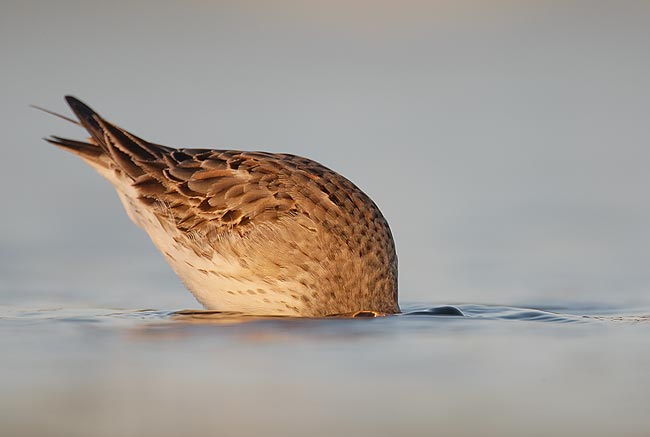
White-rumped Sandpiper, worn, molting adult feeding, East Pond, Jamaica Bay Wildlife Refuge, Queens, NY
Image Copyright 2007: Arthur Morris/BIRDS AS ART
Canon 500mm f/4L IS lens with the 2X II TC and the EOS-1D Mark III. ISO 800. Evaluative metering +2/3 stop: 1/500 sec. at f/8.
The Panning Ground Pod (http://www.birdsasart.com/accs.html#The%20Walt%20Anderson%20Panning%20Ground%20Pod) and late afternoon light helped me to produce this simple yet elegant image. Shorebird experts would recognize the white-rumps long wings and the heavily streaked sides of the breast.
CONGRATS TO DAVID FYLES
Hello Artie, I am writing to personally thank you for sharing your professional knowledge, wisdom and techniques with all aspiring wildlife photographers. For several years I have been following the advice in your "The Art Of Bird Photography" and more recently that in the updated ABPII CD-ROM. Your excellent bulletins which are crammed full of valuable information have been helpful as well. The knowledge gained from following your advice has improved my bird photography skills to a point where I felt that my images were of high enough standard to enter my first-ever photography competition at the local wetland wildlife reserve over here in England. To my amazement one of my images submitted to the 'WWT Nikon Photography Competition' was highly commended; I was awarded third place out of a total of over 200 entries. Thanks again for all of your help. And cheers, David.
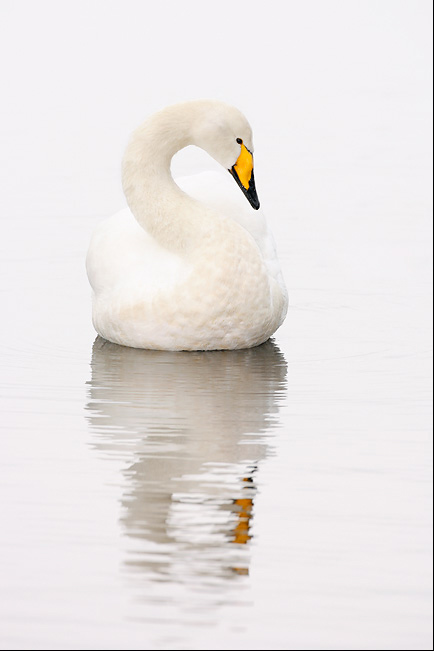
Whooper Swan, WWT Martin Mere, Lancashire, England. Image Copyright 2007: David Fyles
Canon 500 f/4L IS lens with the EOS-1D Mark II N. ISO 250. Evaluative metering at +1 2/3: 1/250 sec. at f/8. Fill flash at -2 stop with Better Beamer. Cloudy white balance. Gitzo 1340 and Wimberley V2.
Congrats David! David asked that I comment on the image. I found it lovely wishing only for a slightly better head angle… Note David’s excellent in-camera exposure settings and use of fill flash.
JIM NEIGER’S FLIGHT SCHOOL WORKSHOPS
Jim Neiger asked me to mention that he has two openings in his first Bosque Flight School and lots of room on the calendar for folks who wish to join him on his Custom/Anytime workshops.
You can learn more about the workshops (including the amazing Best of Florida Workshop) and see some of Jim’s amazing photographs here: http://www.flightschoolphotography.com/Workshops/Current%20Workshop%20Pages/FSP%20Current%20Workshops.htm
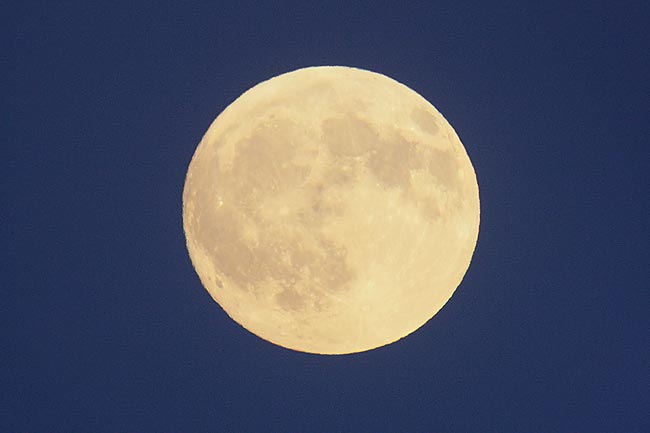
Full moon, Jamaica Bay Wildlife Refuge, Queens, NY
Image Copyright 2007: Arthur Morris/BIRDS AS ART
Canon 500mm f/4L IS lens with stacked 1.4X and 2X II TCs and the EOS-1D Mark III. ISO 3200. Evaluative metering +1 stop: 1/125 sec. at f/8.
To create these full frame moon images I turn AF off, focus manually on the edge of the moon while listening for the focus confirmation beep, and then begin creating images. We had left the north end of the East Pond and hurried to the North Channel Bridge in hopes of finding some cormorants to silhouette. The cormorants were there with their wings stretched but we were about two minutes late… As we turned around to finally head back to the cars we were greeted by this spectacular ful moon.
BOSQUE APTATS WORKSHOPS
Robert O’Toole asked that I pass the following information along:
Bosque #1:”The Fall Color IPT” APTATS Workshop: NOV 12th, 2007. $399: 1 opening.
Bosque #2:”The Pre-Thanksgiving IPT” APTATS Workshop: NOV 16th, 2007. $399: 3 openings.
Bosque #3:”The Post-Thanksgiving IPT”APTATS Workshop: NOV 21st, 2007. Sold out.
The Bosque APTATS workshops are limited to 6 participants. Discounts for groups of 2 or more are available. Please e-mail Robert at robert@robertotoolephotography.com for more info or to register.
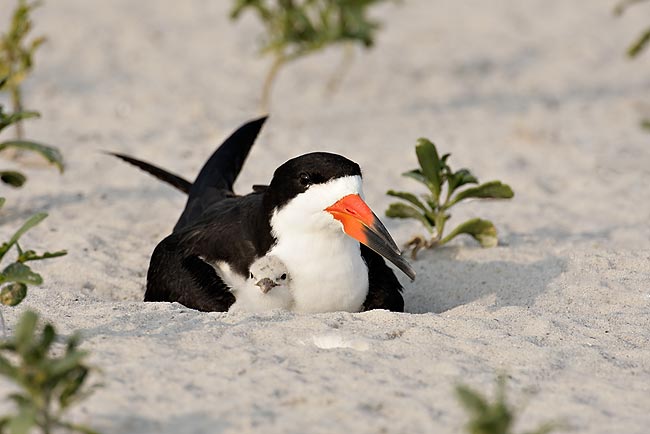
Black Skimmer with tiny chick, Nickerson Beach, Point Lookout, NY
Image Copyright 2007: Arthur Morris/BIRDS AS ART
Canon 500mm f/4L IS lens with the 2X II TC and the EOS-1D Mark III. ISO 250. Evaluative metering +1 stop set manually: 1/250 sec. at f/10.
Bird biology is a complex and amazing subject. Though there were flying young and many fully-grown, ready-to-fledge chicks, there was a small section of the colony where there were about five nests with eggs. After this chick hatched it was a popular spot with the IPT group…
MIII USER’S GUIDE KUDOS & INFO
Via e-mail from Van Hill:
Hi Artie, Thanks for making the Mark III User's Guide available. There are many wonderful, useful and practical aspects to this guide. Your comments on the AF "panic attack" on the internet were thoughtful and objective. That seems to be lacking in 99% of what I read on the forums. Just, as with the Digital Basics Guide, your straight-forward instruction and the practical information that is included is particularly helpful to users like myself who are new to the Canon 1D class cameras. I have read the guide a few times to better understand the rationale and subtle nuances of the settings and functions, as I practice with the new camera. Although I haven't used AI Servo much yet, the guide has helped me learn the camera far better than the manual alone ever could have. Thanks for your masterful teaching and writing style. Van Hill
The MIII UG includes instructions on how to set and use all of the menu items and Custom Functions that I am currently using. The first (but not last) free update included detailed instructions on how to calibrate your lenses with the amazing Micro-Adjustment Custom Function. In addition, the UG includes basic directions for using Digital Photo Professional (DPP), the packaged RAW processing software that comes (on CD) with the MIII. The current versions of BreezeBrowser now support the MIII and the Adobe Camera Raw plug-in for the Mark III RAW is available for use only with CS3. I use only BreezeBrowser to convert all of my Canon images.
You can order your copy of the Mark III User’s Guide PDF right now for $20—by e-mail only. As is usual Paypal is quite convenient; click on any Paypal link on the web site, enter $20 for the cost and MIII UG for the item and hit “OK.” You can call us at 863-692-0906 with credit card in hand, or send a check for the correct amount made out to “Arthur Morris” to us as follows: Arthur Morris/BIRDS AS ART, PO Box 7245, 4041 Granada Drive, Indian Lake Estates, FL 33855.
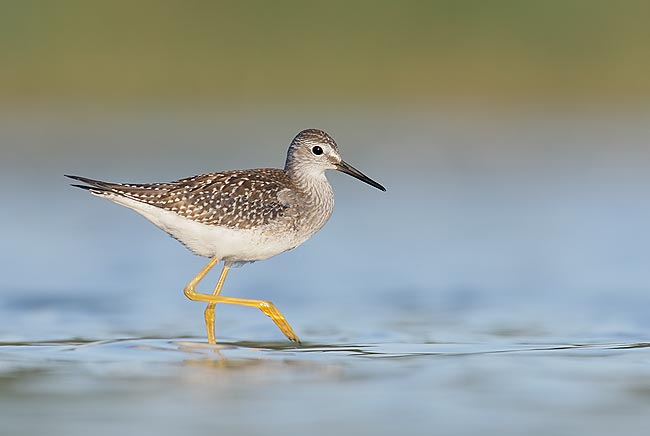
Lesser Yellowlegs, moderately worn juvenile, East Pond, Jamaica Bay Wildlife Refuge, Queens, NY
Image Copyright 2007: Arthur Morris/BIRDS AS ART
Canon 500mm f/4L IS lens with the 2X II TC and the EOS-1D Mark III. ISO 800. Evaluative metering +2/3 stop set manually: 1/500 sec. at f/11.
Here, the raised leg of this foraging yellowlegs adds significant interest to the image.
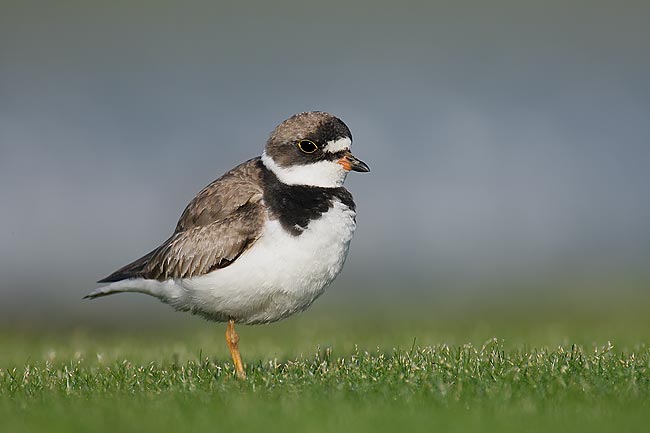
Semipalmated Plover, worn, molting adult, East Pond, Jamaica Bay Wildlife Refuge, Queens, NY
Image Copyright 2007: Arthur Morris/BIRDS AS ART
Canon 500mm f/4L IS lens with the 2X II TC and the EOS-1D Mark III. ISO 500. Evaluative metering +1/3 stop: 1/800 sec. at f/9.
The key to creating this image was picking the right spot. The birds were scattered all over the South Flats so I looked for a spot with short green grass, no dark muddy areas, no geese in the background, and no swan feathers. I found what I was looking for, got down on the ground, and went to work.
MORE EOS 1D MARK III COMMENTS…
Several folks e-mailed asking why I was trying to sell my Mark II 1Ds. Others wrote asking my thoughts on the recently announced EOS 1Ds Mark III. The answers are related. I always loved my 1Ds MII. The 17 mp files were and are simply astounding. But I do not like traveling with two different types of batteries and two different chargers. Once the 1Ds MIII was announced I ordered one immediately through the Canon Explorers of Light Program. I plan on keeping my three MIII bodies, traveling with two of them plus the 1Ds MIII (when it arrives) and having one MIII to rent on IPTs. It’s that simple.
Next question: why the 1Ds MIII for you? The answers:
a-The 21mp images will allow for lots of cropping.
b-The MIII handles contrast far better than any previous digital camera body and with its 14-bit depth capture, produces stunning image files; a sharp image from the 1Ds MIII will surely be mind boggling.
c-I am pretty good at getting close to most birds so when I use the new camera I will not miss the 1.3 crop factor.
d-Same batteries and charger as the MIII.
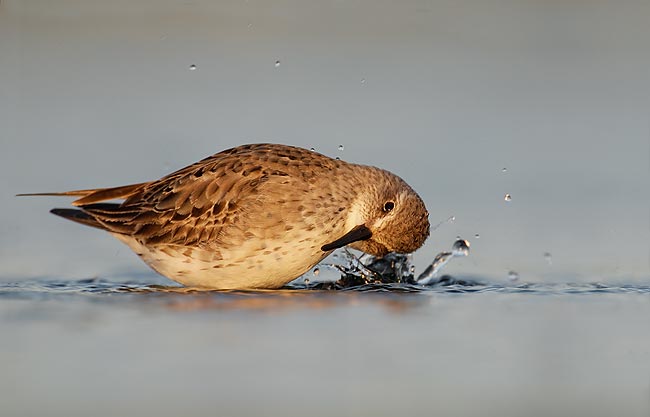
White-rumped Sandpiper, worn, molting adult bathing, East Pond, Jamaica Bay Wildlife Refuge, Queens, NY
Image Copyright 2007: Arthur Morris/BIRDS AS ART
Canon 500mm f/4L IS lens with the 2X II TC and the EOS-1D Mark III. ISO 800. Evaluative metering +1/3 stop: 1/640 sec. at f/9.
When I find a relatively cooperative bird in a good setting, I strive to create a variety of images featuring a variety of behaviors. This is the same white-rump that was portrayed with its head completely under the water above.
IPT UPDATES
Note: All presently scheduled North American IPTs except San Diego (see same below) are currently sold out with waiting lists.
Bosque #1: "The Fall Color IPT" NOV 13-15, 2007. Slide Program on the evening of NOV 12. 3-DAY: $999. (Limit 14; Sold Out). Co-leader: Robert O'Toole. Guest leader (DAY 3 only): Andy Rouse. This IPT should feature a better chance for a day or two of the rare south winds that drastically improve flight photography and will definitely feature the brightest fall-color cottonwoods.
Bosque #2: "The Pre-Thanksgiving IPT" NOV 18-20, 2007. Slide Program on the evening of NOV 17. 3-DAY: $999. (Limit 14; Sold Out). Co-leader: Robert O'Toole, Robert Amoruso, & Alfred Forns. Guest leader: Andy Rouse. This IPT will feature increasing numbers of geese and cranes with lots of great opportunities. In 2007, I will again be hosting a Thanksgiving Day luncheon at Las Lunas Mansion, a fine restaurant in an historic building. You will need to reserve a spot and pay in advance. Details TBA; strictly limited to 50 folks.
Bosque #3: "The Post-Thanksgiving IPT" NOV 24-26, 2007. Slide Program on the evening of NOV 23. 3-DAY: $999. (Limit 14: Sold Out). Co-leaders: Robert O'Toole, Robert Amoruso, and Alfred Forns. This IPT is scheduled on dates that I consider peak for Bosque. (There may be a Full Moon Add-on NOV 23; details TBA.) If you register for this one, hold off on buying your plane ticket if you might be interested in the add-on.) In 2007, I will again be hosting a Thanksgiving Day luncheon at Las Lunas Mansion, a fine restaurant in an historic building. You will need to reserve a spot and pay in advance. Details TBA; strictly limited to 50 folks.
BIG NEWS! SW FLA Post X-mas IPT: DEC 27-29, 2007. Slide program on the of evening Wednesday, DEC 26, 2006. 3-DAY: $1029. (Limit 12; Sold Out). Co-leaders: Alfred Forns, Robert O'Toole, & Robert Amoruso. Joining us as guest co-leader will be full time professional photographer John Moran, Florida's unofficial Photographer Laureate. You can learn about John’s amazing work here: www.johnmoranphoto.com. John will be doing his program, “Journal of Light: A Photographer's Search for the Soul of Florida" for the group on Wednesday, DEC 26 at 3:30 pm. John’s work is so different from mine and from everyone else’s that he has been a huge inspiration to me over the past two years. We will be visiting Sanibel Island, Venice Rookery, Cape Coral, and possibly Little Estero Lagoon (depending on the tides). Herons, egrets, gulls, terns, skimmers, shorebirds, both pelicans, Osprey, Burrowing Owl, and lots more. Roseate Spoonbill and Wood Stork possible.
NEW: San Diego IPT: JAN 20-23, 2008. Slide program on the Saturday early evening of JAN 19. 4-DAYS: $1399. (Limit 12; openings: 8.) LaJolla, LaJolla Shores Beach, Coronado, and Santee Lakes. Brown Pelicans in spectacular breeding plumage, Heerman’s & Western Gulls, Marbled Godwits & lots more shorebirds, Wood & Ring-necked Ducks & Lesser Scaup. Great flight photography. And lots more.
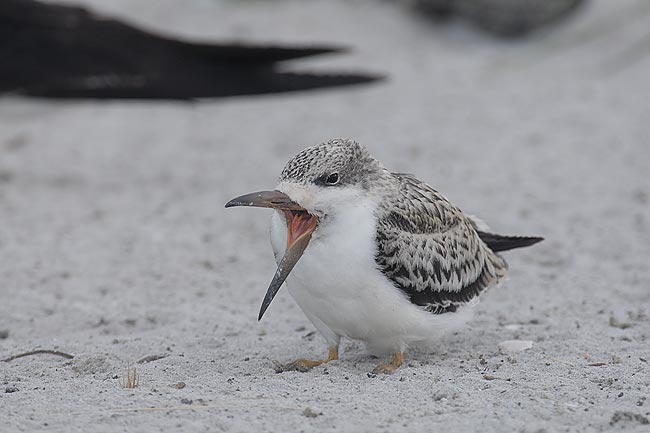
Black Skimmer chick yawning, Nickerson Beach, Point Lookout, NY
Image Copyright 2007: Arthur Morris/BIRDS AS ART
Canon 500mm f/4L IS lens with the 2X II TC and the EOS-1D Mark III. ISO 640. Evaluative metering +2/3 stop: 1/250 sec. at f/10 set manually.
The above image represents the converter RAW file.
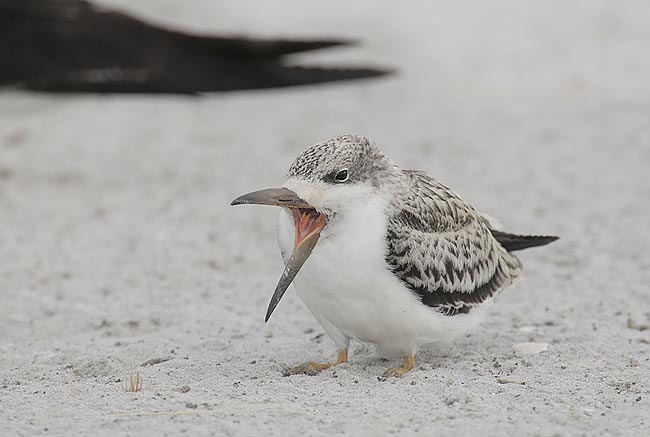
Robert used his Quick Masking techniques to eliminate the bird from the upper right corner of the image, and then did the same to clean up the foreground. Levels and Curves adjustments brightened the image considerably. He liked this image with the adult bird’s rear half in the upper left corner. I liked the cleaner image below so we simply created two versions. Which do you prefer?
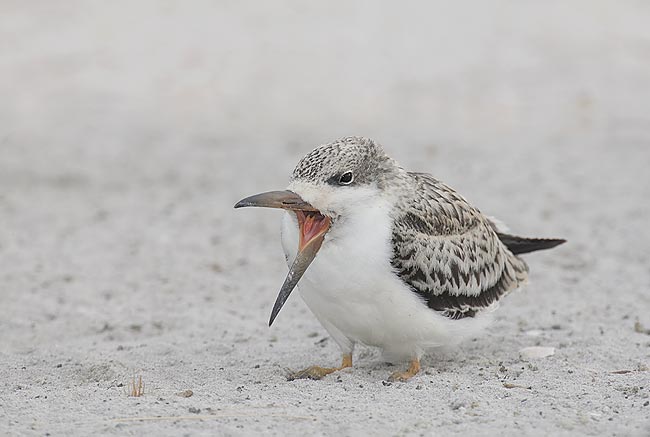
In most instances Quick Masking is far superior to either the Clone Stamp or the Patch Tool for eliminating distracting elements from an image. Regular readers know that there are dozens of other uses for Quick Masking once you have the basics down.
Here are the very basics: Control Q, B, Control Q, Control J, V. It’s that simple. You can learn all about Quick Masking with Robert O’Toole’s APTATS PDF (on CD only): http://www.birdsasart.com/aptats.htm.
You can order your APTATS-1 PDF (on CD only today for $20 plus $3 shipping and handling ($23 total) in the US. Florida residents need to add 7% sales tax: $21.40 plus the $3 shipping and handling ($24.40 total). To Canada the cost is $20 plus $6 shipping ($26 total). For overseas customers the cost will be $20 plus $8 shipping and handling ($28 total). APTATS-1 is being shipped in its final form; it will not be updated. As is usual Paypal is quite convenient. Be sure to include your ship-to address. You can also call us at 863-692-0906 with credit card in hand, or send a check for the correct amount made out to “Arthur Morris” to us as follows: Arthur Morris/BIRDS AS ART, PO Box 7245, 4041 Granada Drive, Indian Lake Estates, FL 33855.
Best and love and great picture-making to all,
artie
Note: Arthur Morris has been a Canon contract photographer since 1994 and continues in that role today. Hunt's Photo of Boston, MA is a BAA sponsor as is Delkin Devices. Back issues of all BAA Bulletins can be found in the Bulletin Archives which may be accessed from the home page at www.birdsasart.com